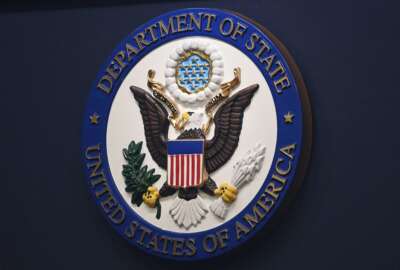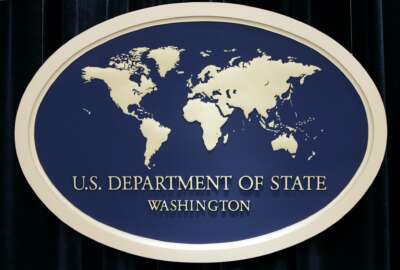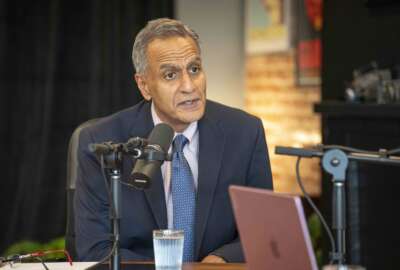State Dept workforce in ‘tough position’ with 13% staffing gap, says deputy secretary
A top State Department official says recent budget cuts are putting more strain on an already overburdened workforce.
A top State Department official says recent budget cuts are putting more strain on an already overburdened workforce.
Congress recently approved a $56.7 billion budget for the State Department for the rest of this year.
That’s a nearly 6% cut compared to spending levels in 2023 — but a less severe cut than the 15% reduction House Republicans had proposed.
Deputy Secretary of State for Management and Resources Richard Verma said Wednesday that this belt-tightening puts the department’s workforce in a tough position, as it responds to a growing set of diplomatic challenges.
“The department will have to make tradeoffs. The dollars are simply unable to stretch as far as we need to meet the moment. And budget cycles do not always align with global realities and crises,” Verma said Wednesday at the Center for Strategic and International Studies.
Verma said lawmakers reaching a 2024 spending deal midway through the fiscal year constrains the department’s ability to respond to emerging challenges in real time.
“None of this is intended to suggest government agencies can’t be innovative and find efficiencies we have, and we will always strive to do so. But I do, however, want to be candid about our reality and the challenges and the constraints we face,” he said.
Verma said the State Department faces an average 13% staff gap, and 15% of ambassador nominees remain unconfirmed.
While the department is looking to rebuild its staffing after a Trump administration hiring freeze and budget cuts, he said the department still doesn’t have the workforce it needs to meet its mission.
“Can you imagine if United Airlines, or Microsoft, or Google, or the University of Virginia had 13% of its positions unfilled? What happens is you end up with incredible workload burdens. You end up shifting certain duties. You end up with posts that don’t have enough people,” Verma said. “We’re in this race to catch up, but you can’t catch up if your budget, like this past year, has been cut by nearly 6%.”
The department currently has about 77,000 employees stationed across nearly 300 embassies, consulates, and domestic operations. Americans in its workforce come from every U.S. state and nearly 20% of employees are veterans.
Among its challenges, the State Department is leading the U.S. response to the ongoing war between Israel and Hamas. It’s also managing a portfolio of emerging threats — including cyberattacks, climate change, global health challenges, the rise of extremist groups and the spread of artificial intelligence tools.
“We can acknowledge that these challenges have stretched the State Department in unprecedented ways. They’ve met working in more places on more issues and problem sets than ever before,” Verma said.
Verma said a national security supplemental proposed by the White House to respond to Ukraine, the Middle East and the Indo-Pacific is “critically needed” for the State Department to respond to these worldwide conflicts.
Over the past year, the department’s Bureau of Consular Affairs cleared out a pandemic-era passport backlog, and processed more than 24 million passport applications and issued over 10 million visas.
About 48% of Americans now have a passport — up from 20% in 2006.
Meanwhile, the department is still coordinating Special Immigrant Visa processing for Afghan allies at over 60 posts worldwide.
Verma said U.S. consular teams in 2023 also assisted 70,000 Americans across the world in times of crisis, “and frankly, personal emergencies that are never on the front pages of any newspaper.”
That includes helping Americans living overseas leave Israel following the Oct. 7 terrorist attack, and helping Americans evacuate Haiti following the ouster of its president.
Verma said the State Department is doing all of this, and “continues to deliver a tremendous value to the American people” at a cost of approximately 1% of annual federal spending.
Verma said the State Department’s base budget grew by about $36 billion since 2000 — but the Defense Department’s budget grew by nearly $600 billion over the same period.
In his first year on the job, Verma has visited more than 30 U.S. overseas missions and about a dozen domestic facilities across the United States.
“At the end of the day, we are a national security agency, with people serving bravely from Ukraine, to Somalia and South Sudan, to Iraq and Port Au Prince, and in so many other conflict zones,” Verma said. “In an age of increased competition, of global interconnectedness of growing authoritarianism, it is vitally important for American diplomats and development professionals to show up everywhere we can to lead, to build, to grow and to deepen cooperation.”
The department, as part of Secretary Antony Blinken’s modernization strategy released last fall, is staffing up its Bureau of Cyberspace and Digital Policy and its Center for Analytics, as well as bringing onboard more subject-matter experts on climate and global health.
The department under this agenda is also reinvesting in its workforce.
“Across all hiring types, we’ve diversified hiring pathways — through paid internships and new authorities —redefined our approach to training and professional development,” Verma said.
The State Department has also launched a retention unit, to pinpoint why Foreign Service members leave the agency midway through their careers, and to make improvements that might encourage them to stay.
Copyright © 2025 Federal News Network. All rights reserved. This website is not intended for users located within the European Economic Area.
Jory Heckman is a reporter at Federal News Network covering U.S. Postal Service, IRS, big data and technology issues.
Follow @jheckmanWFED






